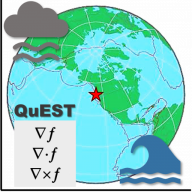Societal urgency, from the proposal: “…modern Earth sciences have changed significantly over the past quarter century, with a much greater emphasis on collaboration across fields, and the deployment of core mathematical and computational techniques to solve complex problems from a range of perspectives. The next generation of students – those who will be responsible for tackling the climate crisis and for developing sustainable resource exploration industries – will need to apply their education much more broadly than ever before.
Visibility / awareness of opportunity: The Earth, ocean, atmospheric, climate and environmental disciplines provide an inspiring and meaningful context for developing both fundamental and applied mathematics, physics and computing knowledge and capabilities. Yet many prospective students and their families are unaware of the potential for rewarding and impactful occupations and the growing need for quantitatively oriented professionals in these fields. Therefore there is a need for “marketing” the disciplines and showcasing the inspiring & rewarding opportunities for studying and practising in these professions.
Timely and ready: UBC’s Department of Earth, Ocean and Atmospheric Sciences has a uniquely diverse range of research interests, degree programs and courses. We also have a history of leadership in science (especially geoscience) education innovation and development. Therefore, we are currently well suited to pursue a re-envisioning of how quantitative subjects are taught and learned, from individual innovations in specific courses to Department-wide curricular initiatives.
The executive summary of the Department’s strategic plan, EOAS 2021: A Vision for Integrated Earth Science (P. Tortell, Dec 7, 2021) articulates the vision that the QuEST project supports. It states that the Department aims to “… expand the use of quantitative and open-source computational methods to address a range of Earth Science questions through advanced data analysis and modelling methods.”
Objectives
From the proposal: “… we seek to critically evaluate current Quantitative Earth Science (QES) offerings across the EOAS undergraduate curriculum, creating a road map to rejuvenate multiple specializations, while forging a new approach to inter-disciplinary education across the Earth sciences. We seek to re-align our undergraduate specializations with the rapidly shifting landscape of Earth Science research, and the corresponding changing employment market. ”
Also “… we will develop market research strategies to learn how students make degree choice decisions, and how renewed QES degree specializations could provide attractive options for interested students. A deeper picture of why people choose QES will significantly inform the creation of better degree specializations, with additional knock-on effects on graduate EOAS programs.”
In parallel (not explicit in the proposal): “Attract & inspire appropriate students to pursue QES degrees and to take QES courses.”
QuEST project goals
- Critically evaluate EOAS’s current QES degrees, courses and students’ experiences.
- Characterize the current state of QES across academic & employment sectors.
- Recommend practical approaches for re-imagining interdisciplinary education and aligning courses & curriculum with existing and emerging employment markets and research priorities.
- Suggest ways to enhance the academic, social and professional experiences of QES students.
- Initiate actions and recommendations to attract, recruit and retain students with quantitative capabilities and interests (e.g. showcase the rewarding & meaningful opportunities available to QES students upon graduation).
Types of Recommendations
Of the five project goals above, three involve making recommendations. Each recommendation will be characterized as generally targeting either “curricular” or “marketing” objectives, and aimed at addressing one or more of these specific objectives:
- Establish new approaches to inter-disciplinary QES education across the Earth sciences.
- Why? to enable our particularly diverse and creative Department to deliver a unique, profound and relevant education in the quantitative Earth sciences.
- Enhance the depth, breadth or relevance of quantitative learning both within QES degrees and for non-EOAS students.
- Why? current learning is somewhat fragmented. Students should be able to attain an increased maturity in these subjects within the 4 years of their degrees.
- Support career awareness and preparation for existing students.
- Why? So our students will be better able to (a) identify opportunities, (b) set appropriate expectations and (c) plan for their success.
- Attract appropriate students into QES degrees.
- Why? because society needs more quantitatively capable earth scientists.
- Why? because corresponding EOAS degree programs are under-enrolled.
- Inspire and motivate enrolled students regarding quantitative aspects of Earth sciences.
- Why? to enhance relevance of, and enthusiasm for, these disciplines.
- Why? to increase the valuable sense of community among QES students & faculty.
- Foster a department culture of efficient & effective engagement with undergraduates.
- Why? students have expressed a desire for more of a sense of “community” that includes them within the Department (Jolley, 2020).
- Why? being more proactive about supporting undergraduate students will improve the Department’s reputation as an attractive place to spend 3 years as an undergraduate.
- Why? engaging more meaningfully with undergraduates can be done with minimal “costs” to faculty and is anticipated to enhance the satisfaction of faculty with regards to their responsibilities as educators.
The 21 categories of recommendations include a total of 149 individual suggested tactics, tasks or ideas. A table of recommendation tactics summarizes their types, target contexts, impacts and anticipated costs. A list of all specific recommendations with links to pages containing details is also provided.
Note that QuEST is not primarily about recommending particular pedagogies, except to sometimes suggest ways of achieving “desirable outcomes”.

